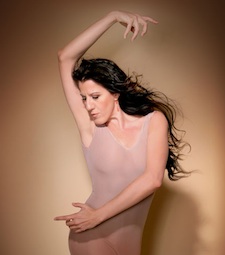I and a friend had the pleasure of seeing Compania Maria Pages perform their ensemble flamenco show "Autorretrato" ("Self Portrait") last night at the New York City Center. The show was breathtaking, a fine example of how this ancient artform still has new life and power.
Despite being staged at the enormous City Center, "Autorretrato" was a very personal and intimate production. Eliminating most of the typical trappings of flamenco — the gaudy costumes, the faux village sets — the dances were mostly performed on a bare stage with the performers wearing plain suits and dresses. The few set pieces of a mirror and three hanging frames were used to terrific effect.
Maria Pages herself is naturally the diva of the production. The "dancer with the endless arms," Ms. Pages does incredible work with her upper body, employing sinuous and serpentine movement in ways that would not be unfamiliar to a popper. The rest of her dancers and musicians were all amazing as well, seamlessly weaving amongst each other and working as a unit.
 That said, paring flamenco down to it's raw essentials — the guitar, the voice, the hand clap, the foot stomp — meant that some in the audience were probably bored at some points in the production. I saw a few folks in our section leave early, well before the final act. Which brings up some of my own issues with flamenco.
That said, paring flamenco down to it's raw essentials — the guitar, the voice, the hand clap, the foot stomp — meant that some in the audience were probably bored at some points in the production. I saw a few folks in our section leave early, well before the final act. Which brings up some of my own issues with flamenco.
Flamenco is kind of a conundrum to me. It can be very raw and emotional, to the point of becoming maudlin and over-sentimental with all the wailing singers and anguished expressions. On the other side, it's very dramatic, with arched backs, thrust chests and flailing arms that always risks seeming cheesy by modern standards. Riding those extremes is what makes well-done flamenco so amazing to see, and bad flamenco so excruciating.
I also find a certain tonal sameness to flamenco, that probably says more about my own ignorance of the form than anything else. To be honest, the flamenco singing style becomes quite grating and overwrought to me after three or four acts. And the danceform has a fairly limited lexicon to draw from, which makes it hard for me to notice special moments or to distinguish individual acts from one another — at least from the cheap seats that we were in.
With that, flamenco is also a reminder of how we can use our entire bodies to be musical. My friend and I got to City Center early to take a free flamenco dance class with about a hundred other enthusiastic amateurs. We learned that nothing is taken for granted in flamenco, from every footfall, to the position of every finger, to every hand clap.
The instructor explained to us that flamenco is at its root about the dancer; the guitarist, the singer, and the percussionist all take their cues from the dancer, who controls the shape and direction of the performance like a conductor. I've never heard of any other other danceform where this is the case.
We had a great time learning a very simple flamenco routine employing foot stomps, arm flourishes, hand claps and dramatic poses. The bailadora warned us though to be careful, "Flamenco is addictive."
The 2010 Flamenco Festival continues until February 21 in New York City.
Nice!! I really liked their performance. It looks like they have worked very hard for this.
Congrats to them for this fantastic performance. Keep it up the good work!!
Show must be awesome? I wish i could attend their show some days.
Thanks for posting this.
Was great to read your thoughts and specifically your ‘conundrum’ with flamenco.
I think the full flamenco experience is an acquired taste, with everything stemming from the cante (the song). the dancer sets the rhythm and tempo, the singer sets the key and structure, the guitarists is in the middle pulling it all together. It’s the singer that inspires but for an English (only) speaking audience to ‘get that’, they need to have a deep understanding of Spanish and Gypsy culture.
Unfortunately most of us just hear wailing!